
Canva, founded in 2013 by Melanie Perkins, Cliff Obrecht, Buebe Lamaz, and Cameron Adams, has transformed the digital design landscape, making it accessible to everyone regardless of design background.
Canva’s intuitive drag-and-drop interface simplifies the design process, ideal for both beginners and professionals.
With its collaborative features and vast template library, Canva has become a go-to tool for creating professional-quality designs quickly and efficiently.
The platform’s ease of use and affordability have made it an attractive option for individuals and businesses alike.
Canva’s broad appeal stems from its ability to cater to diverse audiences, from non-designers to professionals.
Its simplicity makes it ideal for small business owners, educators, and freelancers, while its robust features attract graphic designers seeking efficiency and time-saving shortcuts.
In comparison to industry stalwarts like Photoshop and GIMP, Canva excels in ease of use, accessibility, and cost. Its web-based platform allows users to design from any device, without installation or extensive hardware requirements.

Key factors contributing to Canva’s success include:
– Intuitive drag-and-drop interface
– Collaborative features for simultaneous project work
– Vast library of templates, images, and graphics
– Affordable pricing plans, including a free version
– Accessibility on any device with internet access
from Science and Technology News - Latest science and technology news https://ift.tt/CLG2gK5



